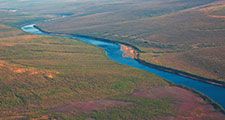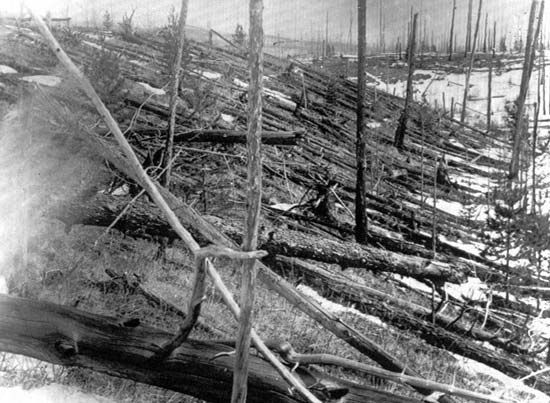Tunguska event
- Date:
- June 30, 1908
Tunguska event, enormous explosion that is estimated to have occurred at 7:14 am plus or minus one minute on June 30, 1908, at an altitude of 5–10 km (15,000–30,000 feet), flattening some 2,000 square km (500,000 acres) and charring more than 100 square km of pine forest near the Podkamennaya Tunguska River in central Siberia (60°55′ N 101°57′ E), Russia. The energy of the explosion is estimated to have been equivalent to the explosive force of as much as 15 megatons of TNT—a thousand times more powerful than the atomic bomb dropped on Hiroshima, Japan, on August 6, 1945. ( Learn what is known and not known about the Tunguska event. )
On the basis of historical records of significant noctilucent cloud development in the skies over Europe following the event, some scientists contend that a comet caused the explosion. Such clouds are thought to be the result of a sudden influx of ice crystals into the upper atmosphere (such as those that could have been triggered by the rapid vaporization of a comet). Other scientists maintain that the event was caused by an asteroid (large meteoroid) perhaps 50–100 metres (150–300 feet) in diameter and having a stony or carbonaceous composition. Objects of this size are estimated to collide with Earth once every few hundred years on average (see impact event, Earth impact hazard). Because the object exploded in the atmosphere high above Earth’s surface, it created a fireball and blast wave but no impact crater. The only likely remains of the object that have been found are a few small fragments, each less than a millimeter across. The radiant energy from such an explosion would be enough to ignite forests, but the subsequent blast wave would quickly overtake the fires and extinguish them. Thus, the Tunguska blast charred the forest but did not produce a sustained fire.
The remote site of the explosion was first investigated from 1927 to 1930 in expeditions led by Soviet scientist Leonid Alekseyevich Kulik. Around the epicentre (the location on the ground directly below the explosion), Kulik found felled splintered trees lying radially for some 15–30 km (10–20 miles); everything had been devastated and scorched, and very little was growing two decades after the event. The epicentre was easy to pinpoint because the felled trees all pointed away from it; at that spot, investigators observed a marshy bog but no crater. Eyewitnesses who had observed the event from a distance spoke of a fireball lighting the horizon, followed by trembling ground and hot winds strong enough to throw people down and shake buildings as in an earthquake. At the time, seismographs in western Europe recorded seismic waves from the blast. The blast had been initially visible from about 800 km (500 miles) away, and, because the object vaporized, gases were dispersed into the atmosphere, thus causing abnormally bright nighttime skies in Siberia and Europe for some time after the event. Additional on-site investigations were performed by Soviet scientists in 1958 through 1961 and by an Italian-Russian expedition in 1999.














